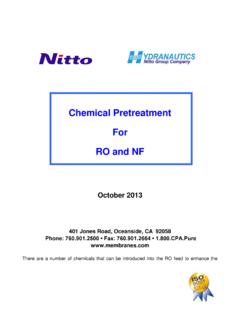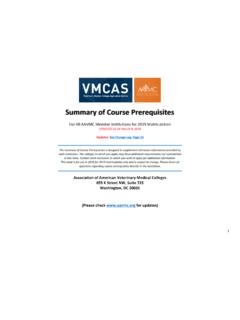Transcription of Dow Water & Process Solutions FILMTEC™ Reverse Osmosis ...
1 Dow Water & Process Solutions FILMTEC Reverse Osmosis Membranes Technical Manual The contents of this manual are for reference purposes and for a better understanding of Reverse Osmosis equipment and operations. The specifics set forth herein may change depending on the operating systems and other conditions. Nothing in this manual should be considered an express or implied warranty. All warranties with respect to any purchase will be provided depending on a specific product and other terms and conditions. Table of Contents 1. Basics of Reverse Osmosis and 7. Historical Background .. 7. Desalination Technologies and Filtration Processes .. 7. Principle of Reverse Osmosis and Nanofiltration .. 10. membrane Description .. 13. membrane Performance .. 14. FILMTEC membrane Safe for Use in Food Processing .. 15. Element Construction .. 16. Element 17. 2. Water Chemistry and 19. Introduction .. 19.
2 Feedwater Type and Analysis .. 20. Scale Control .. 24. Introduction .. 24. Acid Addition .. 25. Scale Inhibitor 26. Softening with a Strong Acid Cation exchange Resin .. 26. Dealkalization with a Weak Acid Cation exchange Resin .. 26. Lime Softening .. 27. Preventive Cleaning .. 28. Adjustment of Operating Variables .. 28. Scaling 28. General .. 28. Calcium Carbonate Scale 30. Brackish Water .. 30. Seawater .. 34. Calcium Sulfate Scale 38. Barium Sulfate Scale Prevention /8/ .. 40. Strontium Sulfate Scale Prevention .. 40. Calcium Fluoride Scale Prevention .. 41. Silica Scale 45. Calcium Phosphate Scale Prevention .. 49. Colloidal and Particulate Fouling 50. Assessment of the Colloidal Fouling Potential .. 50. Media Filtration .. 52. Oxidation Filtration .. 53. In-Line 53. Coagulation-Flocculation .. 54. Microfiltration/Ultrafiltration .. 54. Cartridge Microfiltration .. 54. Other Methods.
3 55. Design and Operational Considerations .. 55. Page 2 of 181 Trademark of The Dow Chemical Company ("Dow") or an affiliated company of Dow Form No. 609-00071-0416. Biological Fouling Prevention .. 56. Introduction .. 56. Assessment of the Biological Fouling Potential .. 56. Culture Techniques .. 57. Total Bacteria Count .. 57. Assimilable Organic Carbon (AOC) .. 57. Biofilm Formation Rate (BFR) .. 58. Chlorination / Dechlorination .. 58. Sodium 60. DBNPA .. 61. Combined Chlorine .. 61. Other Sanitization Agents .. 62. Biofiltration .. 62. Microfiltration/Ultrafiltration .. 62. Ultraviolet Irradiation .. 62. Use of Fouling Resistant Membranes .. 63. Prevention of Fouling by Organics .. 63. Prevention of membrane 63. Prevention of Iron and Manganese Fouling .. 63. Prevention of Aluminum Fouling .. 64. Treatment of Feedwater Containing Hydrogen Sulfide .. 65. Guidelines for Feedwater Quality.
4 66. Summary of Pretreatment Options .. 67. 3. System Design .. 70. Introduction .. 70. Batch vs. Continuous Process .. 73. Single-Module System .. 74. Single-Stage 75. Multi-Stage System .. 75. Plug Flow vs. Concentrate Recirculation .. 76. Permeate Staged System .. 78. Special Design Possibilities .. 79. membrane System Design Guidelines .. 80. membrane System Design Guidelines for 8-inch FILMTEC Elements .. 81. membrane System Design Guidelines for Midsize FILMTEC Elements .. 82. The Steps to Design a membrane System .. 83. System Performance Projection .. 87. System Operating Characteristics .. 87. Design Equations and Parameters .. 89. Testing .. 93. Screening Test .. 93. Application Test .. 93. Pilot Tests .. 94. System Components .. 94. Page 3 of 181 Trademark of The Dow Chemical Company ("Dow") or an affiliated company of Dow Form No. 609-00071-0416. High Pressure Pump .. 94. Pressure 95.
5 Shutdown 95. Valves .. 96. Control 96. Tanks .. 96. Materials of Construction, Corrosion 98. System Design Considerations to Control Microbiological 99. System Design Suggestions for Troubleshooting Success .. 99. 4. Loading of Pressure Vessels .. 101. Preparation .. 101. Element 101. Shimming Elements .. 103. Element Removal .. 104. Interconnector Technology for 8-inch Diameter FILMTEC Elements .. 104. New Interconnector 104. Summary of Large Element Interconnectors .. 106. Installing an Element Spacer .. 106. 5. System Operation .. 108. Introduction .. 108. Initial Start-Up .. 108. Equipment .. 108. Pre-Start-Up Check and Commissioning 109. Start-Up Sequence .. 110. membrane Start-Up Performance and Stabilization .. 112. Special Systems: Double Pass RO .. 112. Special Systems: Heat Sanitizable RO .. 112. Operation 112. RO and NF Systems Shutdown .. 112. Adjustment of Operation Parameters.
6 113. Introduction .. 113. Brackish Water .. 113. Seawater .. 114. Record 114. Introduction .. 114. Start-Up Report .. 114. RO Operating Data .. 115. Pretreatment Operating Data .. 117. Maintenance Log .. 117. Plant Performance Normalization .. 117. 6. Cleaning and Sanitization .. 121. Introduction .. 121. Safety 121. Cleaning Requirements .. 122. Page 4 of 181 Trademark of The Dow Chemical Company ("Dow") or an affiliated company of Dow Form No. 609-00071-0416. Cleaning 122. Cleaning Procedure .. 124. Cleaning Tips .. 125. Effect of pH on Foulant Removal .. 126. Cleaning Chemicals .. 127. Cleaning Procedure for Specific Situations .. 127. General Considerations .. 127. Sulfate Scale .. 127. Carbonate Scale .. 128. Iron Fouling .. 128. Organic Fouling .. 129. Biofouling .. 130. Emergency Cleaning .. 131. Sanitizing RO/NF membrane Systems .. 131. Introduction .. 131. Hydrogen Peroxide and Peracetic Acid.
7 131. Chlorinated and Other Biocidal Products .. 132. Heat Sanitization .. 132. 7. Handling, Preservation and Storage .. 134. General .. 134. Storage and Shipping of New FILMTEC Elements .. 134. Used FILMTEC Elements .. 134. Preservation and Storage .. 134. Re-wetting of Dried Out Elements .. 135. Shipping .. 135. 135. Preservation of RO and NF Systems .. 136. 8. 137. Introduction .. 137. Evaluation of System Performance and Operation .. 137. System Tests .. 139. Visual Inspection .. 139. Type of Foulant and Most Effective Cleaning .. 139. Localization of High Solute Passage .. 140. Profiling .. 140. Probing .. 140. membrane Element Evaluation .. 142. Sample 142. DIRECTORSM Services .. 142. Visual Inspection and Weighing .. 143. Vacuum Decay 143. Performance Test .. 144. Cleaning Evaluation .. 144. Autopsy .. 144. Page 5 of 181 Trademark of The Dow Chemical Company ("Dow") or an affiliated company of Dow Form No.
8 609-00071-0416. membrane Analysis .. 145. Symptoms of Trouble, Causes and Corrective Measures .. 145. Low Flow .. 145. Low Flow and Normal Solute 146. Low Flow and High Solute Passage .. 147. Low Flow and Low Solute Passage .. 149. High Solute 150. High Solute Passage and Normal Permeate Flow .. 150. High Solute Passage and High Permeate Flow .. 151. High Pressure Drop .. 152. Troubleshooting 154. 9. Addendum .. 155. Terminology .. 155. Specific Conductance of Sodium Chloride (Table ) .. 164. Conductivity of 165. Conductivity of Solutions .. 165. Conversion of Concentration Units of Ionic Species .. 167. Temperature Correction Factor .. 168. Conversion of Units into Metric Units .. 169. Ionization of Carbon Dioxide Solutions .. 169. Osmotic Pressure of Sodium Chloride .. 170. Osmotic Pressure of Solutions .. 170. Testing Chemical Compatibilities with FILMTEC Membranes .. 171. Key Word Index.
9 178. Page 6 of 181 Trademark of The Dow Chemical Company ("Dow") or an affiliated company of Dow Form No. 609-00071-0416. 1. Basics of Reverse Osmosis and Nanofiltration Historical Background Since the development of Reverse Osmosis (RO) and ultrafiltration (UF) as practical unit operations in the late 1950's and early 1960's, the scope for their application has been continually expanding. Initially, Reverse Osmosis was applied to the desalination of seawater and brackish Water . Increased demands on the industry to conserve Water , reduce energy consumption, control pollution and reclaim useful materials from waste streams have made new applications economically attractive. In addition, advances in the fields of biotechnology and pharmaceuticals, coupled with advances in membrane development, are making membranes an important separation step, which, compared to distillation, offers energy savings and does not lead to thermal degradation of the products.
10 Basic membrane research is the foundation of FilmTec Corporation. Since the creation of the FILMTEC FT30 membrane , new products have been developed and existing products have undergone enhancements in their ability to improve permeate quality and lower the total cost of Water . In general, RO membranes now offer the possibility of higher rejection of salts at significantly reduced operating pressures, and therefore, reduced costs. Nanofiltration membrane technology provides the capability of some selectivity in the rejection of certain salts and compounds at relatively low operating pressures. FilmTec Corporation was founded in Minneapolis USA in 1977. After evolving product changes and company development between 1981 and 1984, the FilmTec Corporation became a wholly owned subsidiary of The Dow Chemical Company in August 1985. With the intent to assure a continuous, consistent, high quality supply of FILMTEC products to the rapidly growing Reverse Osmosis and nanofiltration markets, Dow has committed significant capital and other resources to upgrade and expand its manufacturing capabilities at FilmTec.




